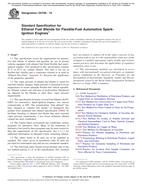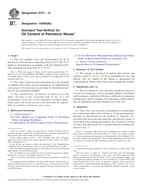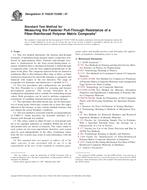1.1 This practice establishes a standard for computing a 99 %/95 % Interlaboratory Detection Estimate (IDE) and provides guidance concerning the appropriate use and application.
1.2 The IDE is computed to be the lowest concentration at which there is 90 % confidence that a single measurement from a laboratory selected from the population of qualified laboratories represented in an interlaboratory study will have a true detection probability of at least 95 % and a true nondetection probability of at least 99 % (when measuring a blank sample).
1.3 The fundamental assumption of the collaborative study is that the media tested, the concentrations tested, and the protocol followed in the study provide a representative and fair evaluation of the scope and applicability of the test method as written. When properly applied, the IDE procedure ensures that the 99 %/95 % IDE has the following properties:
1.3.1 Routinely Achievable IDE Value-Most laboratories are able to attain the IDE detection performance in routine analyses, using a standard measurement system, at reasonable cost. This property is needed for a detection limit to be practically feasible. Representative laboratories must be included in the data to calculate the IDE.
1.3.2 Routine Sources of Error Accounted for-The IDE should realistically include sources of bias and variation which are common to the measurement process. These sources include, but are not limited to: instrinsic instrument noise, some typical amount of carryover error, plus differences in laboratories, analysts, sample preparation, and instruments.
1.3.3 Avoidable Sources of Error Excluded- The IDE should realistically exclude avoidable sources of bias and variation, that is, those which can reasonably be avoided in routine field measurements. Avoidable sources would include, but are not limited to: modification to the sample, measurement procedure, or measurement equipment of the validated method, and gross and easily discernable transcription errors (provided there was a way to detect and either correct or eliminate them).
1.3.4 Low Probability of False Detection-The IDE is a true concentration consistent with a measured concentration threshold (critical measured value) that will provide a high probability, 99 %, of true nondetection (a low probability of false detection, alpha = 1 %). Thus, when measuring a blank sample, the probability of not detecting the analyte would be 99 %. To be useful, this must be demonstrated for the particular matrix being use, and not just for reagent water.
1.3.5 Low Probability of False Nondetection- The IDE should be a true concentration at which there is a high probability, at least 95 %, of true detection (a low probability of false nondetection, beta = 5 %, at the IDE), with a simultaneous low probability of false detection (see 1.3.4). Thus, when measuring a sample at the IDE, the probability of detection would be at least 95 %. To be useful, this must be demonstrated for the particular matrix being used, and not just for reagent water.
Note 1-The referenced probabilities, alpha and beta, are key parameters for risk-based assessment of a detection limit.
1.4 The IDE applies to measurement methods for which calibration error is minor relative to other sources, such as when the dominant source of variation is one of the following (with comment):
1.4.1 Sample Preparation, and calibration standards do not have to go through sample preparation.
1.4.2 Differences in Analysis, and analysts have little opportunity to affect calibration results (such as with automated calibration).
1.4.3 Differences in Laboratories, for whatever reasons, perhaps difficult to identify and elimate.
1.4.4 Differences in Instruments (measurement equipment), which could take the form of differences in manufacturer, model, hardware, electronics, sampling rate, chemical processing rate, integration time, software algorithms, internal signal processing and thresholds, effective sample volume, and contamination level.
1.5 Alternative Data Quality Objectives-Other values for alpha, beta, confidence, etc. may be chosen for calculating an IDE; however, this procedure addresses only the 99 %/95 % IDE.
Product Details
- Published:
- 08/10/2003
- Number of Pages:
- 13
- File Size:
- 1 file , 190 KB


